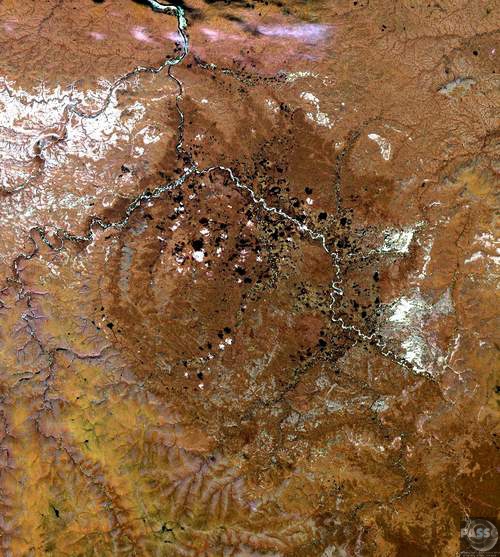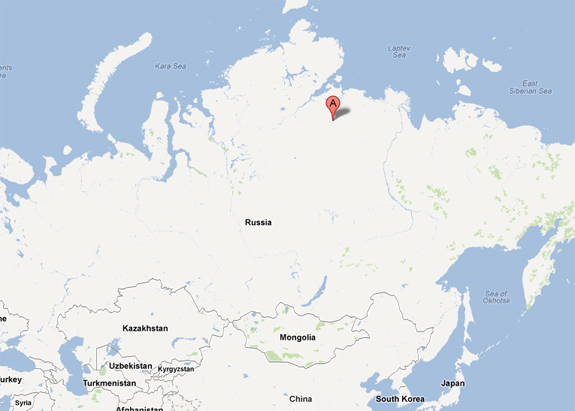Why Is a Russian Crater Teeming with Diamonds?
A meteorite impact 35 million years ago filled a Russian crater with diamonds
Since before the fall of the Iron Curtain, Russia has been keeping quite the secret. But that secret, says Slate, is now out in the open:
According to the latest news out of Moscow, Russia is in control of a previously-secret diamond field that allegedly contains trillions of carats worth of reserves. That number is ten times greater than worldwide reserves, and if accurate, could potentially supply the global market for upwards of 3,000 years.
The Christian Science Monitor explains that the diamond field was found in the 1970s in Siberia’s 90-kilometer wide Popigai crater, which dates back to 35 million years ago.

The Popigai crater, Siberia. Photo: LANDSAT / passc.net
This isn’t the first time the world has heard about the Popigai diamonds, but the Russians had kept the extent of the deposit under wraps. According to PBS Nova, the Siberian diamonds, known as ‘impact diamonds,’ come in clusters that are “nearly half an inch across.”
Diamonds can be formed in a number of ways, but all rely on the interplay of two key variables: heat and pressure. The term ‘impact diamond’ stems from the idea that the diamonds were formed by the intense heat and pressures caused by a meteorite impact.
As geologist Richard April explains to Life’s Little Mysteries, there are two main ways in which impact diamonds can come to be:
One possibility is that a meteorite crashes into an area rich with some form of carbon, such as the remains of living organisms. The high pressures and temperatures of the collision would be enough to turn the terrestrial carbon into diamond.
In the second scenario, the carbon arrives inside a meteorite and, at the moment of impact, flash-fuses into diamonds that are dispersed in the ground.
These two mechanisms of diamond formation by collision, however, tend to only make small collections of diamonds, not the massive bounty that Russia is claiming. April says that a third highly unlikely but possible mechanism could have played out in the Russian arctic: a meteorite could have hit an existing diamond field, increasing the number of diamonds and in the process changing their properties.
The way in which the diamonds are formed affects their properties, such as their size, hardness, and the levels of impurities. The Associated Press says that Russia’s new trove is full of diamonds that are chock full of impurities. This makes them a poor candidate for jewelers, but great for industrial or scientific uses where the diamond’s hardness is valued over its shine.
More from Smithsonian.com:
Gem Gawking
Diamonds on Demand
Diamonds Unearthed
/https://tf-cmsv2-smithsonianmag-media.s3.amazonaws.com/accounts/headshot/smartnews-colin-schultz-240.jpg)

/https://tf-cmsv2-smithsonianmag-media.s3.amazonaws.com/accounts/headshot/smartnews-colin-schultz-240.jpg)